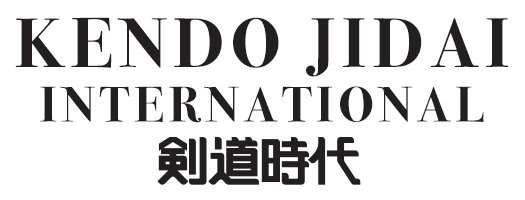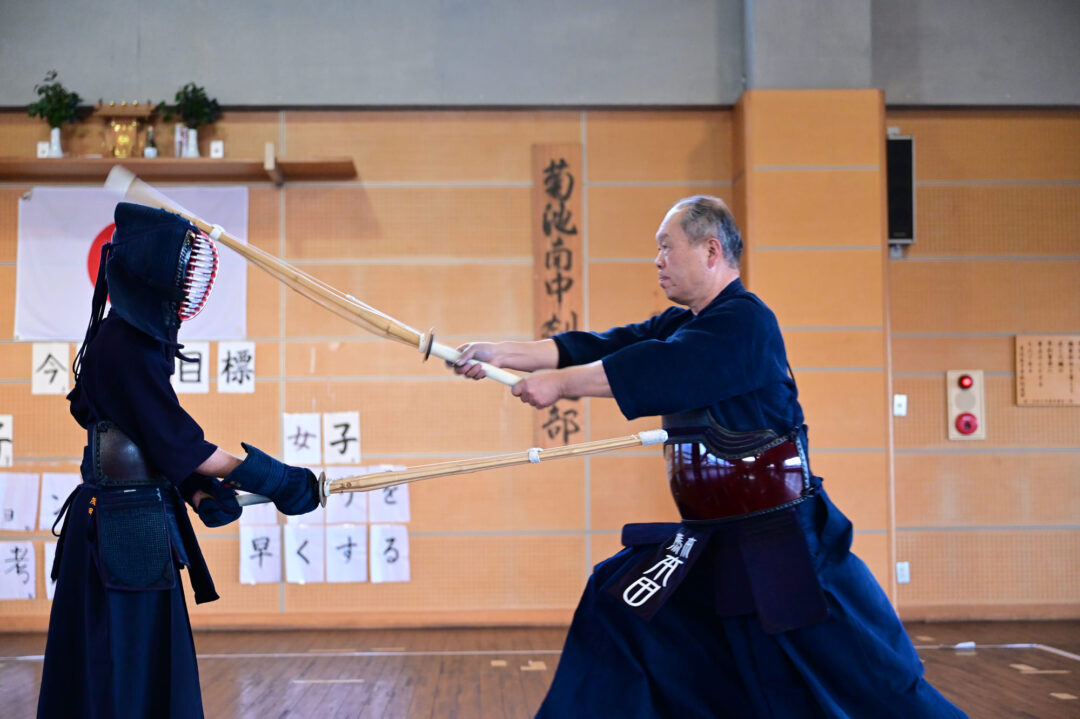2025.5 KENDOJIDAI
Composition: Teraoka Tomoyuki
Translation: Sato Mariko, Pepijn Boomgaard
Photography: Nishiguchi Kunihiko
*Unauthorized reproduction or use of any images in this article is strictly prohibited.
After a period away from Dan examinations, Honda Kiyozumi Kyoshi passed the most challenging 8th Dan examination on his first attempt. Most of his training partners up to now have been the students of Kikuchi Minami Junior High School, where he provides instruction.
“Generating power in the body and aiming for sharp strikes — this is the same whether you are a junior high school student or someone of my age. I have always kept this in mind when practicing together with the students,” says Honda Kyoshi.
In this article, he shares the method he has developed through years of teaching experience for adding force and vitality to strikes.
Honda Kiyozumi, Renshi 8th Dan
Honda Kiyozumi was born in 1959 in Kumamoto Prefecture. He began practicing Kendo in the fifth grade of elementary school and went on to Yatsushiro Higashi High School after graduating from Kikuchi Minami Junior High School. As a high school student, he achieved remarkable success, winning titles such as the Gyokuryu-ki and the National Sports Festival.
In his second year at Tokyo University of Agriculture, he left school to take over the family business. Since 1981, he has been providing external instruction for Kikuchi Minami Junior High School, where he has continued to teach for over 40 years. Many of his students, including Ogata Yuki and Iwashita Tomohisa, have gone on to excel in Kendo.
Achieving 8th Dan Through Practice with Junior High School Students
Last August, I was fortunate enough to pass the 8th Dan examination. For me, it was my first promotion exam in 20 years, since I passed the 7th Dan at the age of 45.
People often ask me, “Why didn’t you take the exam sooner?” but the truth is, there wasn’t any particular reason. Ever since I left university at the age of 21 to take over the family business, I have been providing external instruction at my alma mater, Kikuchi Minami Junior High School, for over 40 years.
Nowadays, the number of club members has decreased, but when I first started coaching, it was during the height of the Kendo boom, and the club had many members. Within Kumamoto Prefecture, our team was among the strongest, often competing for the top spots. I remember that back then, we would travel to various other junior high schools for matches every weekend, leaving me with hardly any time for myself.
When it came to the Dan examination, I progressed smoothly up to 5th Dan. However, from 6th Dan onwards, the examinations are held at the national level, so I chose not to take them for a while.
It just so happened that a classmate of mine was assigned to Kikuchi Minami Junior High School as a teacher, and we decided to take the promotion exam together — that’s when I went for my 6th Dan. I believe I was around 39 years old at the time. After that, I obtained my 7th Dan, but once again, nearly 20 years passed without me attempting another exam.
The 8th Dan exam is notoriously difficult, with a pass rate of less than 1%. I honestly thought there was no way someone like me — who only practices with junior high school students — could possibly pass. So I decided I would dedicate myself fully to coaching the students instead.
So why did I decide to take the exam this time? The main reason is that in recent years, I’ve had more opportunities to practice not only with the junior high school students I coach, but also with younger Kendo practitioners.
On top of that, I’ve reached an age where I often feel pain here and there during practice. When I heard about an acquaintance who had to give up attempting the exam after having knee surgery, it made me think that I should give it a try while my body is still able to move.
After I decided to aim for the 8th Dan exam, I began attending the regional practice sessions held at Kikuchi High School, and I started training every day with clear goals in mind.
That said, my main focus has always been practice with the junior high school students. Even though they are junior high students, by the time they reach their third year, they make excellent training partners. Because we practice together every day, they can see right through my intentions, and there are plenty of times when they counter my techniques cleanly. Every time that happens, I remind myself, “I still have a long way to go.”
Of course, I believe it’s important to practice with senior teachers as well, but I sometimes wonder how much it really improves one’s skills to simply be overwhelmed by a great teacher’s presence and not be able to do anything in the match. It would be ideal to cut through that force and strike back, but that’s not something easily done.
I believe that repeatedly engaging in evenly matched Keiko with junior high school students helped me steadily build my true strength — and that this was one of the reasons I was able to pass the exam this time.
What I always keep in mind during practice is to perform Kendo that is worthy of my current rank. This goes back a long time, but when I earned my 1st Dan, my teacher at the time told me, “Passing 1st Dan doesn’t mean you are 1st Dan. Passing means you’re now standing at the starting line to begin the true training for 1st Dan.”
That message has stayed with me ever since. When I reached 6th Dan, I trained in a way that was fitting for a 6th Dan. After I attained 7th Dan, rather than focusing on aiming for 8th Dan, I continued practicing with the mindset of pursuing kendo that was appropriate for a 7th Dan.
I feel that it was this approach that ultimately led to my success in passing the exam.
Pursuing Sharpness Through Correct, Fundamental Strikes
The rest of this article is only available for Kendo Jidai International subscribers!


